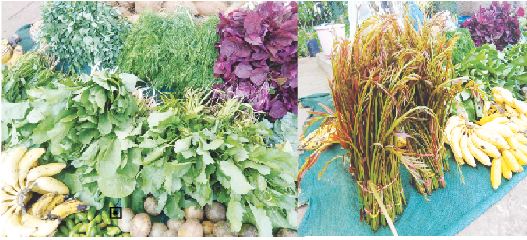WELCOME GOA’S WINTER GREENS…this is the best season to discover all of Goa’s treasury of greens ranging from the familiar spinach or palak, robust red-leafed amaranth or tamdi bhaji, small-leafed methi or fenugreek greens, the fragrant suva or dill greens, radishor mulo greens in plenty, look at the coppery green bunches of ankoor, count yourself lucky if you find Indian purslane or golchi bhaji! Greens offer invaluable nutrients apart from fibre — enzymes (if you can eat them without cooking or lightly steamed), plus mineral values of calcium, magnesium and much more. They make for a perfect accompaniment for an evening meal, go well with pulses, and make for great soups too! Eat more greens to stay alive and kicking and to build up your immunity against coronavirus!
BY TARA NARAYAN
I ALWAYS think of Goa’s winter months and especially the four months of November, December, January and February as months to live on the gauti greens available in the pavement markets of small time farmers who I’m not sure know anything about organic farming but are organic through default! They must be using some chemical fertilizers I tell myself but cannot resist buying the baby greens of red and green amaranth leaves, radish greens are in plenty and in every thali meal in town you’ll find “mulochi bhaji.” Think dill, think baby spinach or palak, think the lovely tender pinkish ankoor, think vavchi bhaji, think golchi bhaji which is rare to see…this is Indian purslane and Lumina Da Costa Almeida tells me you have to wash these greens out in several changes of water to get rid of grit.
The usual Goan way to cook greens is to chop and steam cook in dal or some Goan alsana or kidney beans, in Gujarat we like to cook dill with moong dal. For some reason combining greens with protein rich lentils or beans is a popular thing to do traditionally! In Goa one may cook the chopped greens in their own juices in a terracotta pot and when cooked season with salt, turmeric powder, temper in cumin, asafoetida and broken red chilli if you wish and finally stir in fresh grated coconut before serving. Add a few petals of kokum if you wish for a sour tang. Cooked greens are great laced with rice or eaten with bhakri or roti of various kinds. In Gujarati tradition the evening meal is usually of some lightly cooked greens and whole wheat bhakri laced with shudh ghee and maybe a bowl of sugared milk (my grandparents’ dinner).
Greens make for terrific soups too and very often it is simple to just chop, steam cook and stir them into a raita seasoned with whatever herbal mixture you favour in curd – select from salt, black pepper, mustard paste or the Bengali kausandi, lemon juice, honey. I like my steamed greens seasoned with feta or cottage cheese too.
Many greens one may eat au naturelle and best to do so, especially as in the case of dill greens – a boiled and cubed potato-dill salad is superlative good, toss in dressing of olive oil, seas salt, black pepper, lemon juice, feta cheese, add sunflower seeds/caju/some berries for wee tangy sweetness. Eat more greens au naturelle as possible for they’re rich in vitamin C and folic acid, plus iron and a whole lot of nutrients we can do with.
This is to say look at all the greens coming into the local Goan market these days and buy, buy and cheer up these Omicron coronavirus-infested days! Give your immunity a boost with fresh foods and drinks instead of packaged industrialized deadwood foods, there’re just too many of them in our lives!
